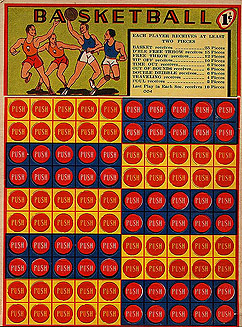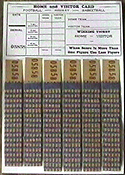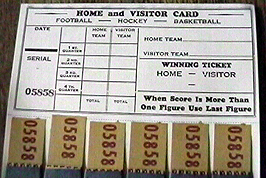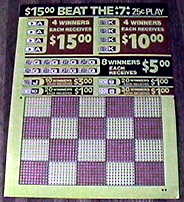Punchboard Variations
 |
|
Typical Pushcard
|
Punchboards have appeared in a number of different forms and in countless design variations. Many people are more familiar with the push-card (or punchcard)-- the punchboard's thinner brother. While a typical punchboard will be ¼ to ¾ inch thick, a punchcard is less than 1/16 inch thick and made out of two pieces of simple card stock. In place of holes filled with folded tickets, a pushcard has perforated circles.. The push-card eliminates the need for a metal punch… you just push the circles out with your finger. In addition to punchboards and push-cards, there are countless versions of pull-tab and seal games. These games may have a different appearance than a punchboard, but they are all essentially the same basic lottery game.
A pushcard is two pieces of cardboard glued together with the outer surfaces having partially perforated circles instead of holes. The player merely pushes his finger or a pencil tip against one of the circles, dislodging two small pieces of cardboard, one of which bears a printed number on its previously hidden surface.
The original pull-tab game probably looked very much like a pushcard except there were a series of seals glued to the face of the card. Each of these seals had a small tab protruding from it to enable the seal to be pulled off the card. On a comparison basis, very few such pull-tab cards now exist.
Folded and banded tickets (sometimes called coupons) are used in jar-ticket games, spindle games (sometimes called "dangling duckets") and carded games. These tickets are normally called pull-tabs or jar-tickets. Jar-ticket games and spindle games used a payout card to advertise the prizes and indicate what tickets were winners. Some of these payout cards contained seals and in some cases the payout card might include a small punchboard. Some of the names used for these games are the same names as were used for punchboards. A game called TWIN REPEAT made by Gay Games used the same award card for a punchboard version, a jar-ticket version and a carded game version. Break-open ticket games are the newest iteration in these sorts of games. Most of these use a payout card, but many of the later games have information regarding prize payout printed on each ticket. These are being cranked out every day by quite a few different companies. Hundreds, maybe thousands, of different games have been made in the last few years.
Even true punchboards have appeared in countless variations. There are punchboards whose payout slips contain numbers, letters, slot machine symbols, and just about any other symbol you can think of. A few punchboards made in the earlier part of this century contained no slips at all. Small metal balls replaced the normal payout slips, with different colors signifying different payoffs. These "ball" punchboards were usually designed to fit into metal frames that collected the balls in a special tube for the operator to examine. Some of these frames were rather intricate, functioning almost like pachinko machines.
  |
|
Pull-tab game for
gambling on sporting events
|
The overall look of the punchboard has changed with the times, and has always been aimed at enticing the player to try his luck. The payoff table might feature slot machine graphics, depictions of money or gold, the ever-present scantily-clad pinup girl, or the occasional political figure. During World War II, players were encouraged to "Take a Punch at Hitler" by several punchboards and push-cards. The boards usually featured a highly characterized and derogatory depiction of the dictator, along with the prizes that patriotic gamblers could expect to win. Folk heroes were also immortalized on numerous boards, with Paul Bunyan being the most popular. The tall woodsman and his blue ox Babe were featured on boards from several different manufacturers.
 |
|
Typical Punchboard
|
One early design variation in punchboards proved to be more successful that any other… the addition of a "bonus" game. Bonus boards featured a special area of punches (or seals) that were not for sale. If the player punched out certain winning tickets in the "normal" area of the board, he was entitled to a free punch in the "bonus" area, where the big money prizes were found. One of the most popular "bonus" boards used a deck of cards as its bonus game. Each card was folded up and sealed, then stapled to the top of the punchboard. When a player punched out certain winning numbers, he was entitled to pull one of the cards off the board and open it. Each of the cards had a dollar value. The prizes ranged from perhaps $1.00 for a two or three, to $20.00 or more for an ace or joker. Not bad for a dime.
Don't forget to bookmark Punchboard.com!